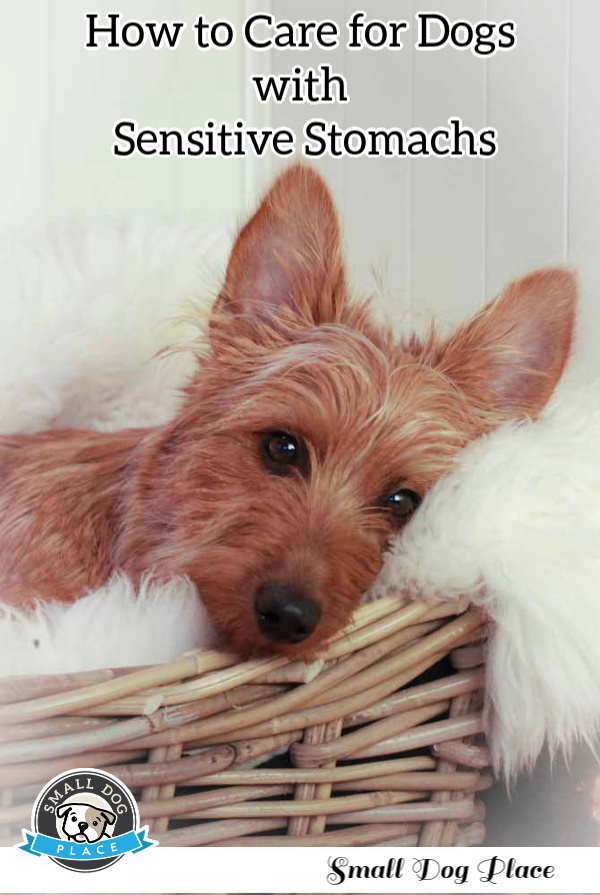- Small Dog Place Home
- Health
- Dogs with Sensitive Stomachs
How to Care for Dogs with Sensitive Stomachs
Dogs with Sensitive Stomachs By Frankie Wallace |Updated 09-27-2022
As a dog owner, we don’t have to tell you that your four-legged friend is an integral part of your family. Like any other family member you love, you don’t want to see them feeling sick!
Unfortunately, some dogs have more sensitive stomachs than others, and some are more prone to dealing with stomach issues.
 Dogs with Sensitive Stomachs
Dogs with Sensitive StomachsIf your furry friend just isn’t acting like they usually do or they look/act sick on a regular basis, it could be something as simple as what you’re feeding them.
Thankfully, that’s an easy problem to fix once you get to the bottom of it, and have a good idea of which foods might actually be better for them.
So let’s take a look at some of the most common causes dogs with sensitive stomachs, what to look for, and how you can ease your dog’s discomfort if they have a sensitive stomach.
What Causes Dogs with Sensitive Stomachs to Have Problems?
What Causes Stomach Issues in Dogs?
There are several common doggy digestive issues that you’ll have to take into consideration if your pup doesn’t seem well after eating.
Some can be healthcare problems that should be taken very seriously, including:
- Bacteria
- A virus
- Bloat
- Worms
- Other Parasites
If you suspect worms or other parasites, you will want to collect a fecal sample and take it to your vet for analysis. If your dog does have worms, medicines will take care of the problem relatively quickly.
In many cases, though, it’s what your dog is consuming that can contribute to their stomach issues. For starters, like humans, dogs can be allergic to certain ingredients — even some of the ones found in a variety of pet foods.
Allergies often show additional symptoms along with stomach issues, including scratching, ear infections, and coughing or sneezing. You can better determine if your dog has food allergies by trying an elimination diet or switching out their food.
But make the change subtle and gradual, as a sudden change in food can contribute to stomach problems, too, especially in dogs with sensitive stomachs.
Aside from the dog food you’re supposed to be giving your pet, many people also tend to feed their four-legged family members “human food.” In many cases, there’s nothing wrong with that. It all depends on what you’re giving them.
Dogs can benefit from the nutritional value of certain fruits and vegetables, and they can also be used as tasty treats that don’t add a lot of calories to your pooch’s diet. Some of the best vegetables for dogs are:
Best Vegetables for Dogs
- Asparagus
- Broccoli
- Carrots
- Celery
- Green beans
- Cucumbers
Dogs can even enjoy certain fruits as an extra special treat, including bananas! Just be sure to give them a small amount and remove the peel, as it can be hard to digest.
If you’re not sure whether a food you typically eat is safe for your dog, your best bet is to do your research ahead of time. Even healthy foods like onions, tomatoes, grapes, and wild mushrooms can be toxic to dogs.
What Are the Most Common Signs of Stomach Problems?
It can seem like stomach issues come on quickly with your dog. One minute, they might be acting normal on a walk or playing, the next minute, something might seem off.
Dogs are resilient, but they’re not immune to feeling sick any more than humans are. Unfortunately, they can’t verbally tell you what’s wrong with them, so it’s important to look for some of the common signs of digestive issues, including:
- Gas
- Noises coming from the stomach
- Constipation
- Diarrhea
- Not wanting to eat
- Vomiting
Most of these symptoms aren’t extremely dangerous or life-threatening, but if your dog starts shaking, panting, or vomits to the point of dehydration, you should seek out medical attention for them from a local veterinarian right away. There could be a very serious problem that needs immediate attention.
How to Know if Your Dog is Dehydrated?
There are two quick checks to determine your dog's hydration level:
1. Check the color of their gums. Gums should be the color of salmon pink and slightly moist or slimy. If it is dry or pale, your dog is dehydrated.
2. Pinch the skin on your dog's back. It should spring back into place immediately. If it is slow to return to it's normal position, or doesn't return at all, your dog is dehydrated.
If your dog is especially sensitive to foods, their environment, or is often simply unwell, one way to stay on top of their health it to work from home (WFH). There are plenty of side hustles that can grow into full-blown WFH careers so you can be your pet’s permanent caregiver.
What Can You Do to Settle Your Dog’s Stomach?
Whether you’re caring for your pet full-time or not, once you get to the root of what is actually causing your dog’s stomach issues, you can make the necessary changes to help them feel better. If it turns out your dog is prone to digestive problems, it may be worth it to invest in pet insurance.
That can make frequent trips to the vet easier on your wallet. In many cases, though, you should be able to help your dog by making changes at home.
One of the best places to start is by changing their food. Many brands make foods specifically designed for dogs with sensitive stomachs, but you don’t necessarily have to buy them as long as you become an active label-reader, and pay attention to the ingredients in your pet’s food.
Look for a food that claims to be complete and balanced, meaning the formula has all of the nutrients your dog needs to be healthy.
Next, look at the ingredient list. If you know your dog is allergic to certain ingredients, that makes it easy to know which foods to avoid. But checking out things like the protein and fiber sources can also help you to determine which foods are better than others.
Foods that use a lot of fillers or have too much fat can irritate your dog’s sensitive stomach. A good rule of thumb is to focus on the first four ingredients. They should consist of proteins and grains. If fat is one of the first four ingredients, that means the content is high.
By making healthy choices with your dog’s food and paying attention to the “people food” you give them, you can keep their sensitive stomachs from getting too worked up, allowing your pooch to stay comfortable, and avoiding too many trips to the vet!
Additional Ideas to Help Dogs with Sensitive Stomachs
Sometime dietary indiscretions may linger and a dose or two of a home remedy may be all that’s needed. Canned pumpkin, oatmeal, or plain yogurt may be helpful. Fresh banana or even banana baby food may also help. You may also want to consider adding probiotics or digestive enzymes to your dog's daily diet.
Restrict Food
Sometimes you will need to restrict food while at the same time maintaining hydration. Before removing any food, be sure your dog is drinking plenty of water and is not dehydrated.
- For small breed dogs, remove dog food for about 12 hours. This can be done overnight.
- Introduce a bland diet of plain rice and some chicken broth
- Slowly add small amounts of bland chicken, rice and broth. (Not Ground beef as it is usually too fatty). Serve 75% rice to 25% bland chicken. White meat chicken works best because it has less fat. Do not add any seasonings.) Feed only one or two tablespoons at a time, several times a day. Watch for symptoms.
- Call your vet if you don't see any improvement with a couple of days.
Dogs With Sensitive Stomachs Pin for Future Reference
Author Bio (Dogs with Sensitive Stomachs)
Frankie Wallace is a freelance writer from Boise, ID. If her spirit animal could be anything, it would be a beagle--inquisitive, and always searching for food.
Other articles on Small Dog Place by Frankie Wallace
Small Dog Obesity: Your Dog Isn't Chunky--It's Obese
The Benefits and Challenges of Having Pets in the Workplace
About Janice (author and voice behind this site)
Having lived with dogs and cats most of her life, Janice served as a veterinary technician for ten years in Maryland and twelve years as a Shih Tzu dog breeder in Ohio.
Her education includes undergraduate degrees in Psychology with a minor in biology, Early Childhood Education, and Nursing, and a master's in Mental Health Counseling.
She is a lifelong learner, a dog lover, and passionate about the welfare of animals. Her favorite breed for over 50 years has been the Shih Tzu, but she has also lived with poodles, Maltese, Yorkshire Terriers, beagles, English bulldogs, carin terriers, and a Cocker Spaniel.
When not writing, reading, and researching dog-related topics, she likes to spend time with her eight Shih Tzu dogs, husband, and family, as well as knitting and crocheting. She is also the voice behind Miracle Shih Tzu and Smart-Knit-Crocheting
Does This Article Deserve Your Thumbs Up?
We always appreciate your support and encouragement. Your thumbs up means so much to us. Please like this article.
If you find this page or any page on Small Dog Place Helpful, or useful in anyway, I'd love it if you would click the small heart found on the bottom right of each page.
You can also share or bookmark this page -- just click on the:

Free Monthly Newsletter
Sign Up for Our Free Newsletter and get our Free Gift to You.
my E-book, The Top 10 Mistakes People Make When Choosing a Dog (and how to avoid them)


